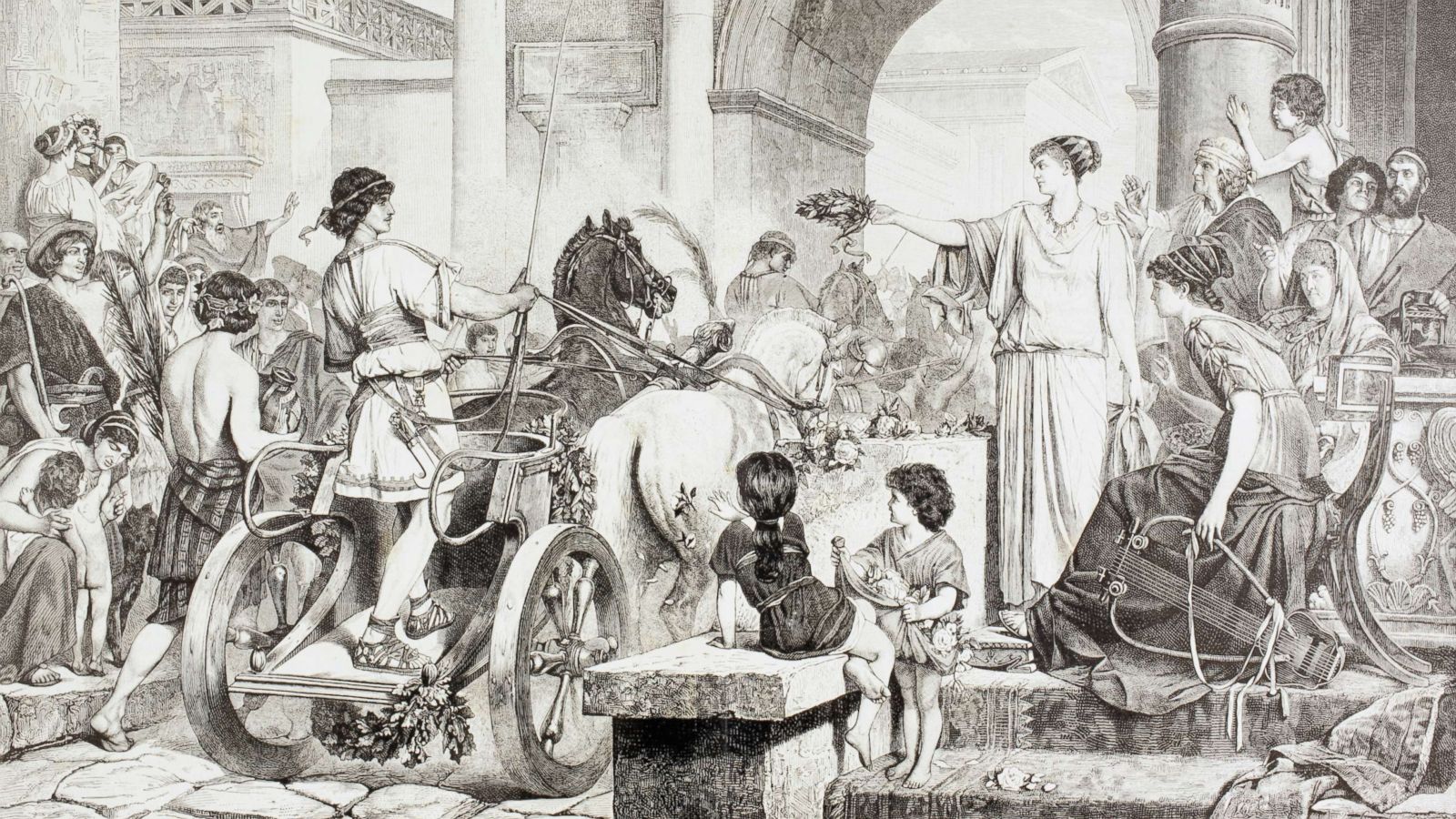
泛希腊运动会是古希腊举行的四场运动会的合称。四场运动会中最古老的是奥林匹克运动会,最早举办于公元前776年。泛希腊运动会的举行十分规律,是希腊人计算时间的方法之一。运动员来自希腊各地,甚至包括从小亚细亚到西班牙的古希腊殖民地,非希腊人和女性不允许参赛。主要赛事有战车赛、摔跤、拳击、五项全能等。比赛胜利者的唯一奖品是一个花冠,没有其他任何金钱或实物奖励。[1] 但赢得比赛者会为其城邦赢得荣誉。
Die Panhellenischen Spiele (griechisch πανελλήνιοι ἀγῶνες maskulin Plural) waren gesamtgriechische Wettkämpfe zu Ehren der griechischen Götter, die an religiösen Kultstätten abgehalten wurden. Ursprünglich handelte es sich um Wettkämpfe unter Kriegern in voller Kriegsmontur. Später wurde mit Ausnahme des Waffenlaufs die Rüstung abgelegt und die Kämpfer traten nackt an. Im Rahmen der religiös-sportlichen Veranstaltung wurden auch kulturelle Wettkämpfe im Dichten und Musizieren ausgetragen.
Zu den panhellenischen Spielen werden die überregionalen Wettkämpfe an vier Kultstätten gezählt: Olympia, Delphi, Korinth und Nemea. Die Sieger aus diesen Wettkämpfen erhielten jeweils ortsspezifische Kränze, Zweige oder Stängel. Der Austragungsmodus dieser Spiele fand meist im Vierjahres-, seltener auch im Zweijahresrhythmus statt. Dieser Rhythmus wurde Periodos (Umlauf, Wiederkehr) genannt. Ein Wettkämpfer, der während einer Olympiade (Vierjahreszyklus) in einer Sportart in allen vier Hauptkampfstätten siegte, erhielt den Titel Periodonike.
"Panhellenic Games" is the collective term for four separate sports festivals held in ancient Greece. The four Games were:
The Olympiad was one of the ways the Greeks measured time. The Olympic Games were used as a starting point, year one of the cycle; the Nemean and Isthmian Games were both held (in different months) in year two, followed by the Pythian Games in year three, and then the Nemean and Isthmian Games again in year four. The cycle then repeated itself with the Olympic Games. They were structured this way so that individual athletes could participate in all of the games.
(But note that the dial on the Antikythera mechanism – [1] – seems to show that the Nemean and Isthmian Games did not occur in the same years.)
Participants could come from all over the Greek world, including the various Greek colonies from Asia Minor to Spain. However, participants probably had to be fairly wealthy in order to pay for training, transportation, lodging, and other expenses. Neither women nor non-Greeks were allowed to participate, except for very occasional later exceptions, such as the Roman emperor Nero.
The main events at each of the games were chariot racing, wrestling, boxing, pankration, stadion and various other foot races, and the pentathlon (made up of wrestling, stadion, long jump, javelin throw, and discus throw). Except for the chariot race, all the events were performed nude.
The Olympic Games were the oldest of the four, said to have begun in 776 BC. It is more likely though that they were founded sometime in the late 7th century BC. They lasted until the Roman Emperor Theodosius, a Christian, abolished them as heathen in AD 393. The Pythian, Nemean and Isthmian games most likely began sometime in the first or second quarter of the 6th century BC. The Isthmian games were held at the temple to Poseidon on the Isthmus of Corinth.
The games are also known as the stephanitic games, because winners received only a garland for victory. (Stephanitic derives from stephanos the Attic Greek word for crown.) No financial or material prizes were awarded, unlike at other ancient Greek athletic or artistic contests, such as the Panathenaic Games, at which winners were awarded many amphorae of first-class Athenian olive-oil. The Olympic games awarded a garland of olives; the Pythian games, a garland of laurel, i.e. bay leaves; the Nemean games, a crown of wild celery, and the Isthmian, a garland of pine leaves in the archaic period, one of dried celery in the Classical and Hellenistic periods, and again one of pine from then on.[1] Though victors received no material awards at the games, they were often showered with gifts and honors on returning to their polis.
Les Jeux panhelléniques sont des fêtes à caractère religieux célébrées en Grèce antique en l'honneur des dieux, auxquels on participait de toutes les régions de Grèce. Ce sont à l'origine des concours athlétiques réservés à l'aristocratie, dont les familles disposaient d'assez de temps et d'argent pour s'entraîner de façon prolongée, et qui attachaient une importance primordiale aux prouesses athlétiques1 ; par la suite, ces compétitions cessèrent d'être l'apanage exclusif de la noblesse, et des jeunes gens issus de la bourgeoisie y remportèrent aussi des victoires ; à partir du Ve siècle av. J.-C., d'autres disciplines culturelles se sont ajoutées aux épreuves athlétiques, puis les athlètes devinrent des professionnels.
I Giochi Panellenici ("di tutti i greci") erano competizioni sportive a carattere sacro che impegnavano tutte le città dell'Ellade (Grecia); una di esse, i Giochi Olimpici, ha dato ispirazione ai giochi olimpici moderni.
Giochi Panellenici è un termine collettivo con cui si indicano quattro diverse manifestazioni sportive che si tenevano nell'antica Grecia. I quattro eventi erano:
- I Giochi olimpici - i giochi più importanti e prestigiosi, si tenevano ogni quattro anni ad Olimpia nell'Elide ed erano dedicati a Zeus.
- I Giochi pitici - si tenevano ogni quattro anni nei pressi di Delfi ed erano dedicati ad Apollo.
- I Giochi nemei - si tenevano ogni due anni a Nemea ed erano anch'essi dedicati a Zeus.
- I Giochi istmici - si tenevano ogni due anni nei pressi di Corinto ed erano dedicati a Poseidone.
I giochi venivano organizzati seguendo un ciclo di quattro anni, noto come Olimpiade, che era uno dei modi in cui gli antichi Greci misuravano il tempo. I Giochi Olimpici venivano presi come punto di partenza, ovvero rappresentavano il primo anno del ciclo; nel secondo anno si tenevano sia i Giochi Nemei che i Giochi Istmici (in mesi diversi), seguiti dai Giochi Pitici nel terzo anno e da una nuova edizione dei Nemei e Istmici nel quarto. A quel punto il ciclo ricominciava con la disputa dei Giochi Olimpici. Erano organizzati in questo modo affinché gli atleti potessero partecipare a tutti i giochi.
Nel 262 a.C. vennero aggiunti i giochi tolemaici a seguito della guerra cremonidea in funzione anti-macedone; questi giochi si tenevano ogni quattro anni ad Alessandria ed erano dedicati a Tolomeo Sotere e Berenice I.[1]
Juegos Panhelénicos es el término que recibe el conjunto de cuatro contiendas diferentes que eran celebradas en la antigua Grecia. Estos cuatro juegos eran los Juegos Olímpicos, los Juegos Píticos, los Juegos Nemeos y los Juegos Ístmicos.
Los Juegos Olímpicos eran los más importantes y prestigiosos, celebrados cada cuatro años cerca de Elis, en honor a Zeus. Los Juegos Píticos también eran celebrados cada cuatro años cerca de Delfos, en honor a Apolo. Los Juegos Nemeos, cada dos años, se celebraban en honor a Zeus en Nemea, aunque en determinadas épocas pasaron a ser realizados en Argos. Los Juegos Ístmicos, en honor a Poseidón, se celebraban en Corinto cada cuatro años.
Los Juegos eran celebrados cada ciclo de cuatro años conocido como Olimpiada, que era una de las medidas de tiempo de la antigua Grecia. En este ciclo, los primeros en celebrarse eran los Juegos Olímpicos que se efectuaban en el primer año; durante el segundo año se celebraban los Juegos Nemeos y los Juegos Ístmicos (en meses diferentes); durante el tercer año acontecían los Juegos Píticos; y en el cuarto año eran nuevamente celebrados los Juegos Nemeos y los Juegos Ístmicos. Después el ciclo se volvía a repetir comenzando nuevamente con los Juegos Olímpicos. Así, los Juegos estaban organizados de forma que un atleta pudiese participar en todos ellos.
Los participantes podían proceder de todo el mundo griego, incluyendo las colonias griegas que se extendían desde Anatolia hasta el Mediterráneo occidental. Sin embargo, los participantes probablemente tenían que ser bastante ricos para poder pagar el entrenamiento, el transporte, el alojamiento y otros costos. Además, no se permitía la participación a las mujeres ni a los no griegos excepto en excepciones muy ocasionales, como con Nerón.
Los principales acontecimientos de cada uno de los juegos fueron las carreras de carros, la lucha olímpica, el boxeo, el pancracio, el stadion junto a otras carreras a pie, y el pentatlón (compuesto por la lucha, el stadion, el salto de longitud, el lanzamiento de jabalina y el lanzamiento de disco). A excepción de las carreras de carros, en el resto de acontecimientos los participantes iban desnudos.
La historia escrita de los Juegos Olímpicos se remonta al 776 a. C., pero realmente se fundó varios siglos antes.[cita requerida] Los otros tres juegos se fundaron en el siglo VI a. C.
Панэллинские игры — общенациональные празднества (греч. πανήγυριν[1], ср. панегирик) в Древней Греции[2], устраивавшиеся в честь богов. Они возникли как спортивные состязания, к которым впоследствии добавились и другие дисциплины.
Первоначально панэллинские игры состояли из следующих этапов, так называемых «периодов»:
- Олимпийские игры — наиболее значимые соревнования, проводившиеся один раз в четыре года в Олимпии в честь бога Зевса. Победители-олимпионики награждались венками из веток оливкового дерева[3].
- Пифийские игры — проводились один раз в четыре года в Дельфах в честь бога Аполлона. Победители награждались лавровыми венками, так как лавр считался священным деревом Аполлона[4].
- Истмийские игры — проводились один раз в два года вблизи Коринфа и посвящались богу Посейдону. Победителям вручали пальмовую ветвь и венок, который в древнейшее и в императорское время плелся из сосновых ветвей, а в классическую эпоху — из сельдерея[5].
- Немейские игры — проводились один раз в два года близ Немеи в честь бога Зевса. Наградой для победителей служили венки из веток оливы или из сельдерея[6].
Атлеты, победившие во всех четырёх панэллинских играх, получали почётный титул периодоника[2].
В эпоху эллинизма панэллинскими играми стали также называть состязания не общегреческого, а местного значения[2].




 Review
Review
 Sport
Sport


